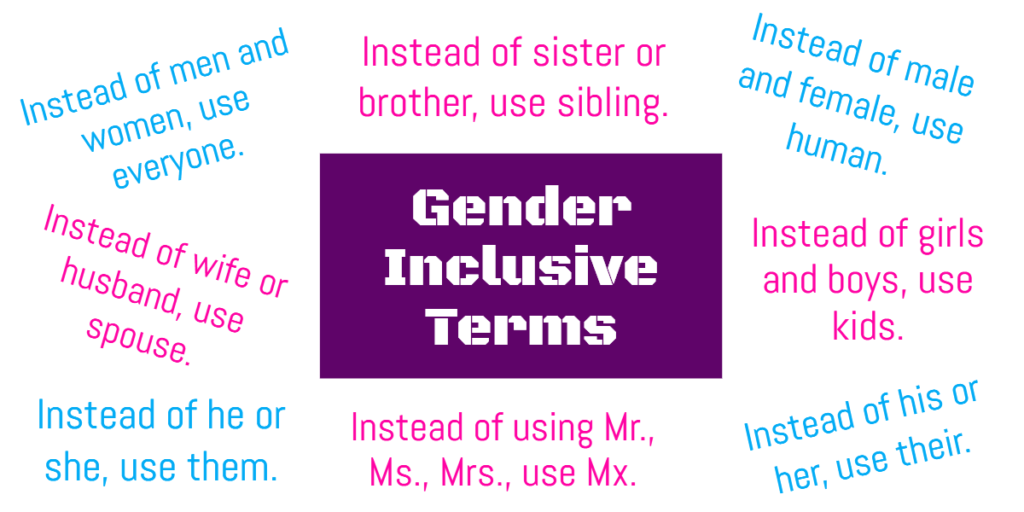|
|
Replacing gendered language with gender inclusive language is powerful step toward equality and moving beyond the binary. Gender inclusive language has many purposes.
First, it recognizes the existence, equality, and presence of women within society.
Second, it recognizes the thousands of people worldwide who don’t conform to traditional gender roles and expectations.
Third, it is inclusive of people who embrace a range of gender non-conforming (GNC) identities.
For this reason, this article presents traditionally gendered terms, followed by simple gender neutral alternatives with which you can substitute them.
I’ve even broken them down by category for your convenience. Enjoy!
Gender Inclusive Language Choices
1. Gender Inclusive Terms for Daily Life
- Instead of he or she, use they.
- Instead of him or her, use them.
- Instead of his or her, use their.
- Instead of men and women, use everyone.
- Instead of male and female, use human.
- Instead of girls and boys, use kids or kiddos.
- Instead of using Mr., Ms., Mrs., use Mx.
2. Gender Inclusive Family Terms
- Instead of wife or husband, use spouse.
- Instead of sister or brother, use sibling.
- Instead of daughter or son, use child or kid.
- Instead of mom or dad (or moms or dads), use parents. Other great alternatives are caregivers, caretakers, family, grown-up, or even adult.
- Instead of grandma or grandpa, use grandparent.
- Instead of niece or nephew, use nibling (a collective term for nieces and nephews or a non-gendered term to describe the children of one’s sibling).
3. Gender Inclusive Work Terms
- Instead of ladies and gentleman, use distinguished guests or honored guests.
- Instead of women or men, use everyone, folks, you all, y’all, or simply people.
- Instead of lady or guy, use person.
Thankfully, co–worker is already a beautifully gender-neutral term!
4. Context Specific Gender Inclusive Terms
- Instead of boys and girls (in a classroom), use students, pupils, you all, y’all or friends.
- Instead of ladies and gents (on a team), use alright athletes, team or people.
- Instead of Almighty Father (in a religious setting), use God or Supreme Being.
5. Gender Inclusive Relationship Terms
- Instead of girlfriend or boyfriend, use partner or significant other.
If you’re feeling a little more creative, you can also use the adorable gender-neutral terms joyfriend or theyfriend.
Importance of Gender Inclusive Language
I am often asked why gender inclusive language matters, and the answer is, it is important for equality.
While gender fluid, nonbinary, and gender non-conforming (GNC) people have existed across all cultures and time periods, these identities are becoming more visible than ever. In recent years, celebrities have begun to openly express their nonbinary identities, activists have been challenging the gender binary, and influencers on social media are embracing a wide range of gender expressions.
Together, these forces are supporting a swell of (long overdue) attention around gender inclusive language.
As explained by Alok Vaid-Menon, a gender non-conforming artist, “All language was invented. That people don’t get mad when new words like ‘tweet’ and ‘hangry’ are developed and recognized, they get mad when new words about gender and sexuality are. The purpose of language is to make meaning — we are constantly creating new ways of fashioning language to be more particular, nuanced, and precise.”
Put simply, words can empower, words can free, and words can be used to respect and recognize the existence of both individuals and groups of people. Being recognized within the lexicon is important.
Or as I say: Language matters.
More Gender Neutral Terms?
What did you think of this list? Were there new ideas for gender neutral terms that you found helpful?
If there are other gender-neutral terms that you’d like to see included, share them in comments and we’ll get them added.


Kathryn elizabeth says
My nephew is gender fluid, but not yet my niece. Is there an appropriate term?
Karen Copper says
The two that I have struggled with are “craftsmanship” (“craftspersonship” is just too much) and “fisherman” (“angler” isn’t quite the same thing).